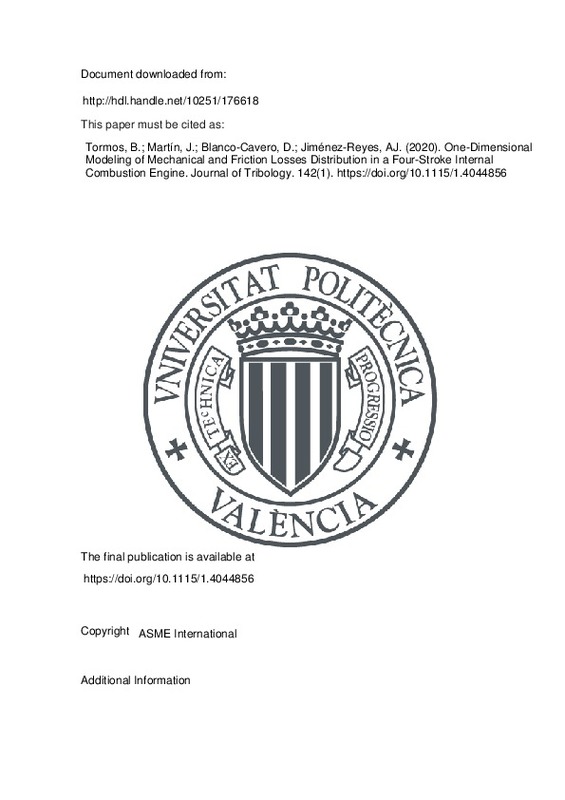JavaScript is disabled for your browser. Some features of this site may not work without it.
Buscar en RiuNet
Listar
Mi cuenta
Estadísticas
Ayuda RiuNet
Admin. UPV
One-Dimensional Modeling of Mechanical and Friction Losses Distribution in a Four-Stroke Internal Combustion Engine
Mostrar el registro sencillo del ítem
Ficheros en el ítem
| dc.contributor.author | Tormos, B.
|
es_ES |
| dc.contributor.author | Martín, Jaime
|
es_ES |
| dc.contributor.author | Blanco-Cavero, Diego
|
es_ES |
| dc.contributor.author | Jiménez-Reyes, Antonio José
|
es_ES |
| dc.date.accessioned | 2021-11-09T04:34:20Z | |
| dc.date.available | 2021-11-09T04:34:20Z | |
| dc.date.issued | 2020 | es_ES |
| dc.identifier.issn | 0742-4787 | es_ES |
| dc.identifier.uri | http://hdl.handle.net/10251/176618 | |
| dc.description.abstract | [EN] As the road transport accounts between 15%-18% of worldwide CO2 emissions, the automotive sector has a deep commitment to mitigate global warming. Consequently, stricter regulations have been adopted by the European Union and worldwide to reduce that big impact. Approximately, 10% of the energy generated by fuel combustion in the engine is destined to the auxiliaries components activation and the movement of mechanical elements with relative motion between themselves. A reduction on that figure or alternatively a mechanical efficiency improvement can be directly translated on target alignment. The aim of this work is developing a model to predict the mechanical and friction losses and its distribution in a four-stroke direct injection-diesel engine and simulating different strategies, which increment the engine efficiency. A 1D model has been developed and fitted in GT-SUITE based on the experimental results of a 1.6-L diesel engine. Additionally, a description of the tribological performance has been realized in different parts of the engine where friction is present. Finally, the engine friction maps have been broken down in order to quantify the friction losses produced in the piston ring assembly, crankshaft bearings, and valvetrain | es_ES |
| dc.language | Inglés | es_ES |
| dc.publisher | ASME International | es_ES |
| dc.relation.ispartof | Journal of Tribology | es_ES |
| dc.rights | Reconocimiento (by) | es_ES |
| dc.subject | Engines | es_ES |
| dc.subject | Friction | es_ES |
| dc.subject | Piston rings | es_ES |
| dc.subject | Pressure | es_ES |
| dc.subject | Pistons | es_ES |
| dc.subject | Journal bearings | es_ES |
| dc.subject | Bearings | es_ES |
| dc.subject | Stress | es_ES |
| dc.subject | Cylinders | es_ES |
| dc.subject.classification | MAQUINAS Y MOTORES TERMICOS | es_ES |
| dc.title | One-Dimensional Modeling of Mechanical and Friction Losses Distribution in a Four-Stroke Internal Combustion Engine | es_ES |
| dc.type | Artículo | es_ES |
| dc.identifier.doi | 10.1115/1.4044856 | es_ES |
| dc.relation.projectID | info:eu-repo/grantAgreement/AEI/Plan Estatal de Investigación Científica y Técnica y de Innovación 2013-2016/TRA2017-89894-R/ES/METODOLOGIA PARA LA PREDICCION DE EMISIONES DE CO2 Y CONTAMINANTES DE UN MOTOR ALTERNATIVO/ | es_ES |
| dc.rights.accessRights | Abierto | es_ES |
| dc.contributor.affiliation | Universitat Politècnica de València. Departamento de Máquinas y Motores Térmicos - Departament de Màquines i Motors Tèrmics | es_ES |
| dc.description.bibliographicCitation | Tormos, B.; Martín, J.; Blanco-Cavero, D.; Jiménez-Reyes, AJ. (2020). One-Dimensional Modeling of Mechanical and Friction Losses Distribution in a Four-Stroke Internal Combustion Engine. Journal of Tribology. 142(1). https://doi.org/10.1115/1.4044856 | es_ES |
| dc.description.accrualMethod | S | es_ES |
| dc.relation.publisherversion | https://doi.org/10.1115/1.4044856 | es_ES |
| dc.type.version | info:eu-repo/semantics/publishedVersion | es_ES |
| dc.description.volume | 142 | es_ES |
| dc.description.issue | 1 | es_ES |
| dc.relation.pasarela | S\406490 | es_ES |
| dc.contributor.funder | AGENCIA ESTATAL DE INVESTIGACION | es_ES |







![[Cerrado]](/themes/UPV/images/candado.png)

